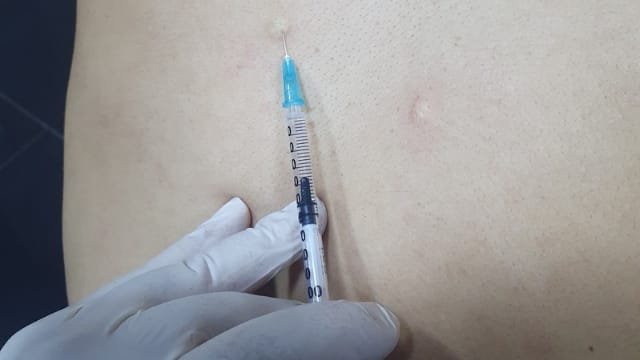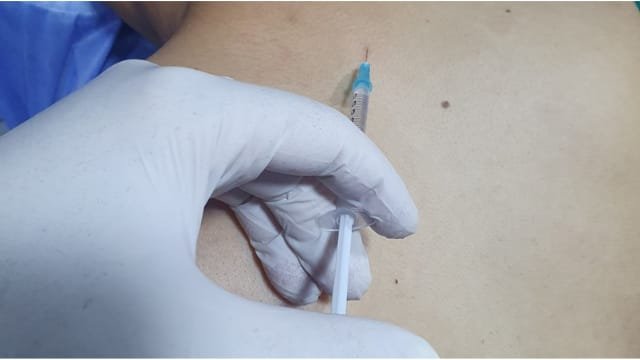دكتور أمجد هزاع

دكتور أمجد هزاع


تشير الأبحاث العلمية الى أهمية استخدام سم النحل في علاج الأمراض السرطانية وتثبت الأبحاث المعملية أن مادة سم النحل مضادة لانتشار الأورام السرطانية ومضادة للنشاط الخلوي السرطاني ويؤكد الباحثين على أهمية الاستخدام العلاجي لمادة سم النحل في علاج الأمراض السرطانية
– أثبتت الأبحاث والأوراق العلمية أن سم النحل مضاد للأورام ومضاد لنشاط السرطان وأن للعلاج بسم النحل له تأثيرات علاجية في حالات السرطان المتعددة مثل سرطان البروستاتا والمبيض والكبد والجلد والمثانة والكلى ويختلف ميكانيزم العلاج بسم النحل باختلاف حالة السرطان.[1], [2], [3], [4], [5], [6], [7], [8], [9], [10], [11], [12], [13], [14], [15], [16], [17], [18], [19], [20], [21], [22], [23], [24], [25], [26], [27], [28], [29], [30], [31], [32], [33], [34], [35], [36], [37], [38], [39], [40], [41], [42], [43], [44], [45], [46], [47], [48], [49], [50], [51], [52], [53], [54]

– وتؤكد ورقة علمية نشرت في عام 2022م للباحثين بكلية العلوم بالأسكندرية، تحت عنوان : جسيمات الشيتوزان النانوية المقترنة بالببتيد المحملة بسم النحل والتي تستهدف الببتيد من أجل العلاج الفعال لسرطان الخلايا الكبدية عن طريق تثبيط مسار MEK / ERK بوساطة EGFR ، كما تؤكد الورقة أنه يحسن وظائف الكبد وبنيته دون التسبب في أي آثار جانبية سامة ملحوظة ، بالإضافة إلى تثبيط نمو الورم عن طريق تنشيط مسار موت الخلايا المبرمج. تصميم هذه الجسيمات النانوية المستهدفة للسرطان يؤسس GE11– سم النحل-CSNPs كعلاج كيميائي محتمل للأورام الخبيثة ، وأفادت الورقة بانه يعتبر سرطان الخلايا الكبدية (HCC) أحد أكثر الأمراض خطورة في العالم بسبب عدم وجود أهداف علاجية واضحة وفعالة من حيث التكلفة. في الوقت الحالي ، تدفع سمية أدوية العلاج الكيميائي التقليدية وتطوير مقاومة الأدوية المتعددة الأبحاث إلى العلاجات المستهدفة. يُنظر إلى إمكانات مجال الطب الحيوي النانوي لتطوير نظام علاجي فعال لإيصال الأدوية بحجم النانو باعتباره اتجاهًا دوائيًا مهمًا لتغليف وإطلاق العديد من العلاجات المضادة للسرطان ، Bee venom-loaded EGFR-targeting peptide-coupled chitosan nanoparticles for effective therapy of hepatocellular carcinoma by inhibiting EGFR-mediated MEK/ERK pathway ولذلك أوصت الدراسة باستخدام سم النحل في علاج حالات السرطان.[21]
كما تؤكد دراسة كورية بمركز الأبحاث الطبية بكلية الصيدلة جامعة تشونجباك الوطنية أن سم النحل مضاد للسرطان في بحث معملي بعنوان Co-culture with NK-92MI cells enhanced the anti-cancer effect of bee venom on NSCLC cells by inactivation of NF-κB وتؤكد في نهاية البحث على استخدام سم النحل في علاج السرطان وبتركيزات قليلة.[55]
– واكد باحثين من كرواتيا أن سم النحل يحمل بين مكوناته مادة المليتين المضادة للسرطان ، كما أكدت دراسة تشيكية أن سم النحل مضاد للسرطان نتيجة لوجود مادة الميليتين والتى تثبط نشاط NF-kappa-B ، كما أكدت دراسة على أن سم النحل مضاد لسرطان المبايض وأن سم النحل فعال في ايقاف نشاط الخلايا السرطانية anti-tumor effect on human ovarian cancer
كما أكدت احدى الدراسات النمساوية في قسم الأمراض البولية بجامعة انسبروك الطبية تقول بأن سم النحل يساعد في علاج سرطان الكلى ، وأكدت مجموعة من الأبحاث والدراسات أن سم النحل له تأثير مضاد للسرطان Antitumor effects على الكبد والمبايض والبروستاتا والمثانة والميلانوما والكليتين بطرق متعددة تعتمد على نوع السرطان.[4], [7], [15], [21], [22], [27], [29], [30], [32], [36], [37], [38], [47], [48], [54], [56]
– وكذلك على مستوى الخلايا العصبية فان سم النحل كما أثبتت الأبحاث ضد الموت المبرمج للخلايا العصبية [57] SH-SY5Y human neuroblastoma cells والذي يسببه 1-methyl-4-phenylpyridinium-induced apoptotic cell death – كما أشار مجموعة باحثين الى حقيقة علاج السرطان بسم النحل ، وأشارت دراسة فرنسية أنه يمكن استخدام سم النحل في صناعة لقاح أو مصل وقائي من السرطانات نتيجة وجود Phospholipase A2 والذي وصفته بـ Good “Chauffeur” لتوصيل رسالة الاجسام المولدة Tumor Antigen الى MHC I and MHC II Peptide ولذلك أوصت الدراسة به [8]
وتؤكد دراسة بكلية العلوم التطبيقية بسنغافورة أن سم النحل يحتوي على Lasioglossin II والذي يعتبر من ضمن العائلات الجديدة المضادة للميكروبات ، والتي تمنع أيضا النشاط السرطاني، وتؤكد دراسات متعددة أن سم النحل مثبط لمادة nuclear factor-kappaB (NF-kappaB) في دراسة على خلايا lipopolysaccharide activated RAW 264.7 cell [56], [58], [59]

وتوصي الأبحاث العلمية باستخدام مستحضر سم النحل البيولوجي وقياس التركيزات الأنسب للمرضى وذلك بعد عمل اختبار حساسية المريض لسم النحل أو مكوناته ويتم العلاج تحت اشراف طبي
[1] Z. Mir Hassani, M. Nabiuni, K. Parivar, S. Abdirad, and L. Karimzadeh, “Melittin inhibits the expression of key genes involved in tumor microenvironment formation by suppressing HIF-1α signaling in breast cancer cells,” Medical Oncology, vol. 38, no. 7, Jul. 2021, doi: 10.1007/s12032-021-01526-6.
[2] S. Kim, I. Choi, I. H. Han, and H. Bae, “Enhanced Therapeutic Effect of Optimized Melittin-dKLA, a Peptide Agent Targeting M2-like Tumor-Associated Macrophages in Triple-Negative Breast Cancer,” Int J Mol Sci, vol. 23, no. 24, Dec. 2022, doi: 10.3390/ijms232415751.
[3] H. L. Lee et al., “Bee venom inhibits growth of human cervical tumors in mice,” Oncotarget, vol. 6, no. 9, pp. 7280–7292, 2015, doi: 10.18632/oncotarget.3110.
[4] X. Yu et al., “Melittin-lipid nanoparticles target to lymph nodes and elicit a systemic anti-tumor immune response,” Nat Commun, vol. 11, no. 1, Dec. 2020.
[5] L. E. Bermudez and L. S. Young, “Tumor necrosis factor α stimulates mycobactericidal/ mycobacteriostatic activity in human macrophages by a protein kinase C-independent pathway,” Cell Immunol, vol. 144, no. 2, pp. 258–268, Oct. 1992, doi: 10.1016/0008-8749(92)90243-I.
[6] I. H. Han, C. Jeong, J. Yang, S. H. Park, D. S. Hwang, and H. Bae, “Therapeutic Effect of Melittin–dKLA Targeting Tumor-Associated Macrophages in Melanoma,” Int J Mol Sci, vol. 23, no. 6, Mar. 2022, doi: 10.3390/ijms23063094.
[7] S. Tang et al., “MnO2-melittin nanoparticles serve as an effective anti-tumor immunotherapy by enhancing systemic immune response,” Biomaterials, vol. 288, Sep. 2022, doi: 10.1016/j.biomaterials.2022.121706.
[8] C. Almunia et al., “Bee Venom Phospholipase A2, a Good ‘Chauffeur’ for Delivering Tumor Antigen to the MHC I and MHC II Peptide-Loading Compartments of the Dendritic Cells: The Case of NY-ESO-1,” PLoS One, vol. 8, no. 6, Jun. 2013, doi: 10.1371/journal.pone.0067645.
[9] C. Lee et al., “Targeting of M2-like tumor-associated macrophages with a melittin-based pro-apoptotic peptide,” J Immunother Cancer, vol. 7, no. 1, Jun. 2019, doi: 10.1186/s40425-019-0610-4.
[10] Y. Lv et al., “Melittin Tryptophan Substitution with a Fluorescent Amino Acid Reveals the Structural Basis of Selective Antitumor Effect and Subcellular Localization in Tumor Cells,” Toxins (Basel), vol. 14, no. 7, Jul. 2022, doi: 10.3390/toxins14070428.
[11] C. Lyu, F. Fang, and B. Li, “Anti-Tumor Effects of Melittin and Its Potential Applications in Clinic,” Curr Protein Pept Sci, vol. 20, no. 3, pp. 240–250, Jun. 2018, doi: 10.2174/1389203719666180612084615.
[12] Y. J. Jeong, Y. Y. Park, K. K. Park, Y. H. Choi, C. H. Kim, and Y. C. Chang, “Bee Venom Suppresses EGF-Induced Epithelial-Mesenchymal Transition and Tumor Invasion in Lung Cancer Cells,” American Journal of Chinese Medicine, vol. 47, no. 8, pp. 1869–1883, 2019, doi: 10.1142/S0192415X19500952.
[13] S. Eltaher, G. F. Mohammed, S. Younes, and A. Elakhras, “Efficacy of the apitherapy in the treatment of recalcitrant localized plaque psoriasis and evaluation of tumor necrosis factor-alpha (TNF-α) serum level: A double-blind randomized clinical trial,” Journal of Dermatological Treatment, vol. 26, no. 4, pp. 335–339, Jul. 2015, doi: 10.3109/09546634.2014.990411.
[14] K. Ertilav and M. Nazıroğlu, “Honey bee venom melittin increases the oxidant activity of cisplatin and kills human glioblastoma cells by stimulating the TRPM2 channel,” Toxicon, vol. 222, Jan. 2023, doi: 10.1016/j.toxicon.2022.106993.
[15] U. A. Fahmy et al., “Potentiality of raloxifene loaded melittin functionalized lipidic nanovesicles against pancreatic cancer cells,” Drug Deliv, vol. 29, no. 1, pp. 1863–1877, 2022, doi: 10.1080/10717544.2022.2072544.
[16] Y. W. Kim, P. K. Chaturvedi, S. N. Chun, Y. G. Lee, and W. S. Ahn, “Honeybee venom possesses anticancer and antiviral effects by differential inhibition of HPV E6 and E7 expression on cervical cancer cell line,” Oncol Rep, vol. 33, no. 4, pp. 1675–1682, Apr. 2015, doi: 10.3892/or.2015.3760.
[17] J. Y. Kim et al., “Effects of bee venom against Propionibacterium acnes-induced inflammation in human keratinocytes and monocytes,” Int J Mol Med, vol. 35, no. 6, pp. 1651–1656, Jun. 2015, doi: 10.3892/ijmm.2015.2180.
[18] M. Liu, H. Wang, L. Liu, B. Wang, and G. Sun, “Melittin-MIL-2 fusion protein as a candidate for cancer immunotherapy,” J Transl Med, vol. 14, no. 1, 2016, doi: 10.1186/s12967-016-0910-0.
[19] J. Zhou, C. Wan, J. Cheng, H. Huang, J. F. Lovell, and H. Jin, “Delivery Strategies for Melittin-Based Cancer Therapy.,” ACS Appl Mater Interfaces, vol. 13, no. 15, pp. 17158–17173, Apr. 2021, doi: 10.1021/acsami.1c03640.
[20] M. M. Rocha et al., “A new therapeutic approach for bone metastasis in colorectal cancer: intratumoral melittin.,” J Venom Anim Toxins Incl Trop Dis, vol. 28, p. e20210067, 2022, doi: 10.1590/1678-9199-JVATITD-2021-0067.
[21] S. Abdulmalek, N. Mostafa, M. Gomaa, M. El-Kersh, A. I. Elkady, and M. Balbaa, “Bee venom-loaded EGFR-targeting peptidecoupled chitosan nanoparticles for effective therapy of hepatocellular carcinoma by inhibiting EGFR-mediated MEK/ERK pathway,” PLoS One, vol. 17, no. 8 August, Aug. 2022, doi: 10.1371/journal.pone.0272776.
[22] A. Wang, Y. Zheng, W. Zhu, L. Yang, Y. Yang, and J. Peng, “Melittin-Based Nano-Delivery Systems for Cancer Therapy,” Biomolecules, vol. 12, no. 1, Jan. 2022, doi: 10.3390/biom12010118.
[23] J. Choi et al., “Suppressive effects of bee venom acupuncture on paclitaxel-induced neuropathic pain in rats: Mediation by spinal α2-adrenergic receptor,” Toxins (Basel), vol. 9, no. 11, Nov. 2017, doi: 10.3390/toxins9110351.
[24] M. A. Moga, O. G. Dimienescu, C. A. Arvǎtescu, P. Ifteni, and L. Pleş, “Anticancer activity of toxins from bee and snake venom-an overview on ovarian cancer,” Molecules, vol. 23, no. 3, 2018, doi: 10.3390/molecules23030692.
[25] H. Zhu, D. Chen, X. Xie, Y. Li, and T. Fan, “Melittin inhibits lung metastasis of human osteosarcoma: Evidence of wnt/β-catenin signaling pathway participation,” Toxicon, vol. 198, pp. 132–142, Jul. 2021, doi: 10.1016/j.toxicon.2021.04.024.
[26] W. R. Lee, S. C. Pak, and K. K. Park, “The protective effect of bee venom on fibrosis causing inflammatory diseases,” Toxins (Basel), vol. 7, no. 11, pp. 4758–4772, Nov. 2015, doi: 10.3390/toxins7114758.
[27] C. Zhou et al., “TERT promoter regulating melittin expression induces apoptosis and G0/G1 cell cycle arrest in esophageal carcinoma cells.,” Oncol Lett, vol. 21, no. 1, p. 16, Jan. 2021, doi: 10.3892/ol.2020.12277.
[28] J. P. Feng et al., “Melittin-encapsulating peptide hydrogels for enhanced delivery of impermeable anticancer peptides,” Biomater Sci, vol. 8, no. 16, pp. 4559–4569, Aug. 2020, doi: 10.1039/c9bm02080b.
[29] S. Lv, M. Sylvestre, K. Song, and S. H. Pun, “Development of D-melittin polymeric nanoparticles for anti-cancer treatment,” Biomaterials, vol. 277, Oct. 2021, doi: 10.1016/j.biomaterials.2021.121076.
[30] D. Gao, J. Zhang, L. Bai, F. Li, Y. Dong, and Q. Li, “Melittin induces NSCLC apoptosis via inhibition of miR-183.,” Onco Targets Ther, vol. 11, pp. 4511–4523, 2018, doi: 10.2147/OTT.S169806.
[31] H. J. An et al., “Inhibitory effects of bee venom on Propionibacterium acnes-induced inflammatory skin disease in an animal model,” Int J Mol Med, vol. 34, no. 5, pp. 1341–1348, Nov. 2014, doi: 10.3892/ijmm.2014.1933.
[32] M. A. Salama, M. A. Younis, and R. M. Talaat, “Cytokine and inflammatory mediators are associated with cytotoxic, anti-inflammatory and apoptotic activity of honeybee venom,” J Complement Integr Med, vol. 18, no. 1, pp. 75–86, Mar. 2021, doi: 10.1515/jcim-2019-0182.
[33] J. S. Kim, H. J. Lee, S. H. Lee, and B. H. Lee, “Recurrent Oligodendroglioma Treated with Acupuncture and Pharmacopuncture,” JAMS Journal of Acupuncture and Meridian Studies, vol. 8, no. 3, pp. 147–151, Jun. 2015, doi: 10.1016/j.jams.2015.03.004.
[34] F. Jia et al., “Bottlebrush Polymer-Conjugated Melittin Exhibits Enhanced Antitumor Activity and Better Safety Profile,” ACS Appl Mater Interfaces, 2021, doi: 10.1021/acsami.1c14285.
[35] J. H. Lee, J. Gang, E. Yang, W. Kim, and Y. H. Jin, “Bee Venom Acupuncture Attenuates Oxaliplatin-Induced Neuropathic Pain by Modulating Action Potential Threshold in A-Fiber Dorsal Root Ganglia Neurons,” Toxins (Basel), vol. 12, no. 12, Dec. 2020, doi: 10.3390/toxins12120737.
[36] R. Yu, M. Wang, M. Wang, and L. Han, “Melittin suppresses growth and induces apoptosis of non-small-cell lung cancer cells via down-regulation of tgf-β-mediated erk signal pathway,” Brazilian Journal of Medical and Biological Research, vol. 54, no. 2, pp. 1–9, 2021, doi: 10.1590/1414-431×20209017.
[37] R. Yan, W. Dai, R. Wu, H. Huang, and M. Shu, “Therapeutic targeting m6A-guided miR-146a-5p signaling contributes to the melittin-induced selective suppression of bladder cancer,” Cancer Lett, vol. 534, May 2022, doi: 10.1016/j.canlet.2022.215615.
[38] N. Oršolić, “Bee venom in cancer therapy,” Cancer and Metastasis Reviews, vol. 31, no. 1–2, pp. 173–194, Jun. 2012.
[39] N. M. El Bakary, A. Z. Alsharkawy, Z. A. Shouaib, and E. M. S. Barakat, “Role of Bee Venom and Melittin on Restraining Angiogenesis and Metastasis in γ-Irradiated Solid Ehrlich Carcinoma-Bearing Mice,” Integr Cancer Ther, vol. 19, 2020, doi: 10.1177/1534735420944476.
[40] W. K. B. Khalil, N. Assaf, S. A. Elshebiney, and N. A. Salem, “Neuroprotective effects of bee venom acupuncture therapy against rotenone-induced oxidative stress and apoptosis,” Neurochem Int, vol. 80, pp. 79–86, 2015, doi: 10.1016/j.neuint.2014.11.008.
[41] B. Cheng and P. Xu, “Redox-Sensitive Nanocomplex for Targeted Delivery of Melittin,” Toxins (Basel), vol. 12, no. 9, Sep. 2020, doi: 10.3390/toxins12090582.
[42] T. Kreinest, I. Volkmer, and M. S. Staege, “Melittin increases cisplatin sensitivity and kills km-h2 and l-428 hodgkin lymphoma cells,” Int J Mol Sci, vol. 22, no. 1, pp. 1–12, Jan. 2021, doi: 10.3390/ijms22010343.
[43] F. Salimian, M. Nabiuni, and E. Salehghamari, “Melittin Prevents Metastasis of Epidermal Growth Factor-Induced MDA-MB-231 Cells through The Inhibition of The SDF-1α/CXCR4 Signaling Pathway.,” Cell J, vol. 24, no. 2, pp. 85–90, Feb. 2022, doi: 10.22074/cellj.2022.7626.
[44] K. Daniluk, A. Lange, M. Pruchniewski, A. Małolepszy, E. Sawosz, and S. Jaworski, “Delivery of Melittin as a Lytic Agent via Graphene Nanoparticles as Carriers to Breast Cancer Cells.,” J Funct Biomater, vol. 13, no. 4, Dec. 2022, doi: 10.3390/jfb13040278.
[45] W. H. Kim et al., “Bee venom inhibits Porphyromonas gingivalis lipopolysaccharides-induced pro-inflammatory cytokines through suppression of NF-κB and AP-1 signaling pathways,” Molecules, vol. 21, no. 11, Nov. 2016, doi: 10.3390/molecules21111508.
[46] B. G. Eid et al., “Melittin and diclofenac synergistically promote wound healing in a pathway involving TGF-β1,” Pharmacol Res, vol. 175, Jan. 2022, doi: 10.1016/j.phrs.2021.105993.
[47] X. Li et al., “Melittin induces ferroptosis and ER stress-CHOP-mediated apoptosis in A549 cells,” Free Radic Res, vol. 56, no. 5–6, pp. 398–410, 2022, doi: 10.1080/10715762.2022.2131551.
[48] G. H. Mansour et al., “Bee venom and its active component Melittin synergistically potentiate the anticancer effect of Sorafenib against HepG2 cells,” Bioorg Chem, vol. 116, Nov. 2021, doi: 10.1016/j.bioorg.2021.105329.
[49] Y. J. Jeong et al., “Melittin has a chondroprotective effect by inhibiting MMP-1 and MMP-8 expressions via blocking NF-κB and AP-1 signaling pathway in chondrocytes,” Int Immunopharmacol, vol. 25, no. 2, pp. 400–405, 2015, doi: 10.1016/j.intimp.2015.02.021.
[50] C. cui Liu et al., “Application of bee venom and its main constituent melittin for cancer treatment,” Cancer Chemother Pharmacol, vol. 78, no. 6, pp. 1113–1130, Dec. 2016, doi: 10.1007/s00280-016-3160-1.
[51] K. I. Kasozi et al., “Bee Venom—A Potential Complementary Medicine Candidate for SARS-CoV-2 Infections,” Front Public Health, vol. 8, Dec. 2020, doi: 10.3389/fpubh.2020.594458.
[52] N. Krayem and Y. Gargouri, “Scorpion venom phospholipases A2: A minireview,” Toxicon, vol. 184, pp. 48–54, Sep. 2020, doi: 10.1016/j.toxicon.2020.05.020.
[53] H. S. Choi, S. Y. Kang, D. H. Roh, S. R. Choi, Y. Ryu, and J. H. Lee, “Bee venom stimulation of a lung meridian acupoint reduces inflammation in carrageenan-induced pleurisy: An alternative therapeutic approach for respiratory inflammation,” J Vet Sci, vol. 19, no. 5, pp. 708–715, 2018, doi: 10.4142/JVS.2018.19.5.708.
[54] P. Erkoc et al., “The Pharmacological Potential of Novel Melittin Variants from the Honeybee and Solitary Bees against Inflammation and Cancer,” Toxins (Basel), vol. 14, no. 12, Dec. 2022, doi: 10.3390/toxins14120818.
[55] P. S. Kollipara et al., “Co-culture with NK-92MI cells enhanced the anti-cancer effect of bee venom on NSCLC cells by inactivation of NF-κB,” Arch Pharm Res, vol. 37, no. 3, pp. 379–389, 2014, doi: 10.1007/s12272-013-0319-8.
[56] J. K. Badawi, “Bee venom components as therapeutic tools against prostate cancer,” Toxins (Basel), vol. 13, no. 5, May 2021, doi: 10.3390/toxins13050337.
[57] Z. Ghorbani et al., “Melittin administration ameliorates motor function, prevents apoptotic cell death and protects Purkinje neurons in the rat model of cerebellar ataxia induced by 3-Acetylpyridine,” Toxicon, vol. 205, pp. 57–66, Jan. 2022, doi: 10.1016/j.toxicon.2021.11.008.
[58] H. Gu, S. M. Han, and K. K. Park, “Therapeutic effects of apamin as a bee venom component for non-neoplastic disease,” Toxins (Basel), vol. 12, no. 3, 2020, doi: 10.3390/toxins12030195.
[59] G. Lee and H. Bae, “Bee venom phospholipase A2: Yesterday’s enemy becomes today’s friend,” Toxins (Basel), vol. 8, no. 2, Feb. 2016, doi: 10.3390/TOXINS8020048.